 For safer and more reliable terminal operations, it is important to know location of all products and their needed movements. Without clear visibility into the real-time health and operational status of the assets required for movements through the facility, problems can occur. One operational risk is in the lineup of the manual and automatic valves. Improper positions can result in unsafe conditions, unintended movements, or other operational issues.
For safer and more reliable terminal operations, it is important to know location of all products and their needed movements. Without clear visibility into the real-time health and operational status of the assets required for movements through the facility, problems can occur. One operational risk is in the lineup of the manual and automatic valves. Improper positions can result in unsafe conditions, unintended movements, or other operational issues.
In this storage terminal safety podcast, we are joined by Emerson’s Kurtis Jensen to discuss specific technologies that provide the highest level of reliability and safety. These technologies enable technicians, users and operators to detect issues and monitor for correct valve positions with and reduce the number of times they need to send staff into hazardous locations.
Podcast: Play in new window | Download (Duration: 19:41 — 10.8MB) | Embed
Subscribe: Apple Podcasts | Spotify | Email | RSS | More
Visit the Terminal Safety, Wireless Pressure Relief Valve (PRV) Monitoring and Wireless Valve Position Monitoring sections on Emerson.com for more on some of the technologies discussed. Also, links have been added in the transcript below for specific products and technologies discussed.
Transcript
Jim: Hi, everybody. I’m Jim Cahill from the Emerson Automation Experts blog. And today we’re going to have another in our continuing podcast series on Enabling Storage Terminal Safety. And for today, I’m joined by Kurtis Jensen and we’ll be discussing Reducing Manual Valve Lineup Mistakes. Kurt, why don’t we start out by letting you introduce yourself and give us a little bit of your educational background and path to where you are today with Emerson?
Kurtis: Okay, Jim, for everybody, I started long ago, in 1981, with an associate degree in electronics. And my first assignment was performing on-site field service work for both analog and digital process control, both valves and instrument measurement. I then moved from there into more of a product engineering role for electronics and software. I started doing more and more software and utility things with troubleshooting and supporting customers. I next went into SCADA and RTU development doing both firmware and software that’s used in our North American pipeline markets. And during that time, I became heavily involved in telecommunication and telecommunication designs from local area networks to wide area networks. And I became involved with several of the communication giants in pioneering what’s now known as internet-based networks to improve speed and reduce costs.
And at that point, I became more heavily involved with Emerson and expanding their wide area network globally. I then obtained my bachelor’s and master’s degree during that time. From there, I went back into the product development side and worked with WirelessHART, our internal WirelessHART team, and the external FieldComm WirelessHART group. And we developed Fisher instruments to target valve solutions that will help users with critical reliability needs. And today, I’m currently working with FieldComm and other standards boards in developing next-generation technologies to bring future step changes in valve and process control innovations.
Jim: Wow, that’s a varied background and a lot of area around seeing this technology as it’s developed and all the way through to today with the wireless and I think that’s a great segue into what we’re talking about, in trying to reduce manual valve lineup mistakes in these storage terminals. So why is reducing valve lineup mistakes a key part of every storage terminal facility’s safety initiative?
Kurtis: Jim, there are many instances and stories I’ve discussed with end-users where mistakes continued in their operations, and they were struggling with them. In many cases, the infrastructure they had was dated, and making additions in their infrastructure or their finances was unfeasible. And that was especially where control system I/O or wiring were just simply prohibitive. The warning signs that these customers, clients, users discussed were as simple as delays in their production facilities. But most of the user’s related products bills or emission releases that were concerning. And those issues resulted in sometimes they had to do cleanup, and sometimes when it dealt with the emissions, they could not re-enter those areas because of some of those releases. And some of the warning signs that they talked about that started with this was distracted technicians where they were busy doing other things and couldn’t get back to what was probably important. And there’s a number of reasons why they were distracted.
But this also led to more and more the operators going out in the field, leaving the control room, going back out, doing things that led them to not watching their full plant. And both those technicians and the operators were being asked to do more, and with less people or less things around them to help them. And then they started to recognize some of their near misses. And then they started to look at process improvements, and in some cases, they resulted in short-term results but with the passage of time, the mistakes returned and continued, and in some cases, they became worse, and simply because of a false sense of protection from some of those process improvements.
Jim: Yeah, it sounds like that’s a lot they have to do without any kind of feedback coming from and all these manual valves, making sure they’re all in the exact position they need to be to move these products through the storage terminal, I guess in and out and everything. And I imagine a lot of these facilities have only manual valves based on their age. So these mistakes I can see happening. What would be your recommendation for them in terminals like this that have mostly manual valves?
Kurtis: So I talked to a number of customers and what I would do is kind of use what they have told me. And they all look at the same things, and they look at three different areas that they have concerns, and that’s where they target. First is, when they go to a startup or they go to a shut down or they’re changing over, they look at where all the valves need to be. And as we discussed a little earlier, spills and leaks, and releases are a no-no. And I need to provide management with assurances that the past episodes don’t return. I had a chemical customer and the spill they encountered cost them roughly $25,000 each, you know, that included cleanup, disposal, what they had to document to the environment, or what they had to document to management. The same customer had three spills within a period of four months prior to our conversation. And he asked his group the following valve lineup questions before startups, “Are all valves lined up correctly?” And if not, how much effort did they need to put them in the state that they could proceed? And does sending people out to verify change, does that include a safety risk or a safety concern?”
Jim: Yeah, that’s interesting for it, so trying to verify everything being lined up correctly. What would be your recommendation to them to be able to drive improvements, I guess, not only in safety but environmental compliance and everything else that happens from mistakes?
Kurtis: Well, what the customer, the clients that we’ve talked to so far, where I would tell them to start and where they have started, is looking at those previous near misses, or maybe where they had issues in the past, those are the biggest targets for safety improvement. But followed closely by that, is those valves that require the most attention, those that take people away and take a lot of their time. And then followed closely after that is those that force or take those operators out of the control room and makes them, I would call it semi-blind or whatever, while they’re out of the control room dealing with things that they probably don’t need to. These other…the last two lead to distractions in the facility, they increase risks to the people and facilities, not to mention the surrounding community.
From a financial point of view, it’s easy to put together and provide an ROI that gets the attention and approval in short order when they talk about safety. But when you look at a second part of this, is looking at kind of where you start conversations with either management or operations. And that question that typically comes up is, what if you already knew the state of every valve related to your shutdown or startup? And the conversations usually go around or center around, like, you don’t need to worry about waiting on resources, because you already know what state those valves are. But maybe more important is your ability to keep people away from hazardous environments completely. And those two points really drive most of the conversations or most of the progress towards finding a solution.
Jim: Okay, so what are some of the specific technologies that we can bring to help ensure the valves are in the right position before they do what they need to do?
Kurtis: So, Jim, when you look at the technologies out there, the ones that provide the highest level of reliability and confidence are the ones that the people really go towards, and the ones with wireless is becoming more and more important. And the technology out there that really has caught on the most is WirelessHART. And the reasons why it caught on, I think, is not only the reliability that the WirelessHART technology provides but it also enables those technicians and the users and the operators, they use the same exact tools that they’re used to with other instruments that’s already in their plant. And some of the WirelessHart technologies out there, and we discussed about this is, is manual valve position or valve position monitoring on manual valves is one. But you also can have valve position feedback on, I’ll call it semi-automated valves. You know, most of these are quarter-turn valves, and maybe they have a solenoid on them, but they still don’t know if the valve is where it needs to be and that can solve quite a few problems.
There’s also valve position feedback on pressure relief valves. You wouldn’t have thought of that. But if you know a pressure relief valve position feedback, it also increases, you know, the safety within the plant. And there’s also valve position feedback on some of the automated control valves out there that have a positioner but they don’t have position feedback on them as well. So you mentioned manual valves, but when they look at all of the opportunity to get visibility that they don’t have today, there are a lot of solutions out there to provide that feedback. And the result is they reduce the number of times they need to send people into hazardous environments but then they can also look at maybe even a step forward past that is maybe they can think of or incorporate that feedback maybe in some of their permissives or some of their interlock designs.
Jim: Yeah, I was just thinking that, that if you’re getting all this feedback in, one, you can display it to the operators, but you can also use it before you start the pumps, commence the transfer, everything else, are they where they need to be? So I guess the wireless information isn’t necessarily part of the control strategy, but it’s performing checks to say, “Hey, before you move forward with it, that’s okay.” Is that a correct understanding do you think?
Kurtis: Well, yeah, I think the users can do it both ways, as you said is, is just a feedback for the control to provide the operators a higher level of understanding or a higher level of awareness and it can be just as simple as an indication on some of their control screens or HMIs that, yes, the valves out there for this, I’ll just call it a chemical plant, in a terminal storage, the valves are where they need to be before they take the next step and give that confidence and assurance that they’re not going to have the mistakes they have had in the past.
Jim: Yeah, that sure seems like it beats the alternative of someone having to go and check everything and make sure it is, and like, you said, they’re out of the control room when that’s happening so they may be missing some alarms and other things going on in there. I guess just one other question I had that occurred to me, so for the facility managers you talk to or for the folks that are in the plants speaking with the facility managers, how do they typically get started?
Kurtis: Well, the first thing, I think, is looking at how to provide operators with the visibility or a better view of what is happening that will enable them to make better decisions and sooner. And in order to do that, they have to look at reducing the complexity with some of the views to their system and maybe they look at their control systems or their I/O is dated. And they can’t go down that approach. They have to look at newer technologies, and maybe they’ve looked at wireless. But they really want or what they should really look at is those technologies that provide the greatest confidence, those technologies that deliver highest levels of reliabilities. And you don’t want to install something only to recognize, I’ll just call it periodic outages, or downtime of those technologies from either obstructions or construction projects or those technologies that are more difficult to set up or integrate with their system. Once you have those pieces together, you have a better solution to eliminate those mistakes, those valve lineup mistakes because you have a visibility that you didn’t have before that provides that step change and safety.
Jim: Well, this has been a fascinating conversation and I learned a lot and I hope our listeners have too. Where can our listeners go to learn more?
Kurtis: So, Jim, as you discuss, there’s other solutions similar to this with…Emerson can show. There’s many WirelessHART solutions out there. What we talked about was just a couple of solutions focused around valves and focused around terminal storage, but they can go to the Emerson website, emerson.com, and look under either PRVs (pressure relief valves), or Fisher Wireless, or go to the Emerson.com/terminal-safety, and find more information. And they can also reach out and connect with me in LinkedIn or contact anybody within our Emerson team and get information on this as well.
Jim: Well, that’s great. And I’ll make sure to add a link to your LinkedIn profile for those that hear it and want to reach out to you, but also the contact section of the website can get someone local in their area. Well, Kurt, thank you so much for joining us today.
Kurtis: Well, and Jim, thank you for reaching out and I enjoyed this conversation and I hope that others find it beneficial and they can use it within their facilities as well.
Jim: Excellent. Thanks.
End of transcript






